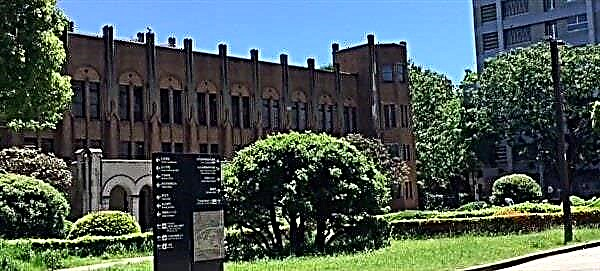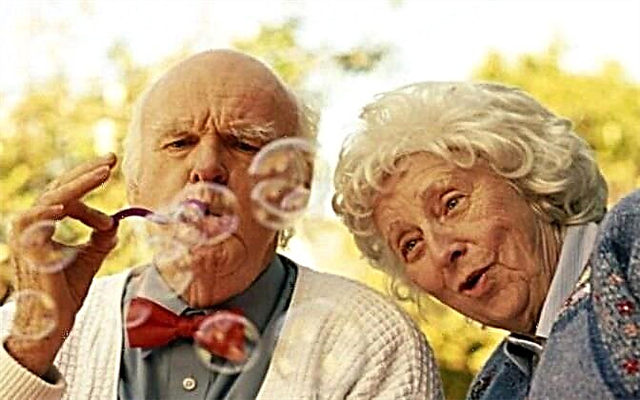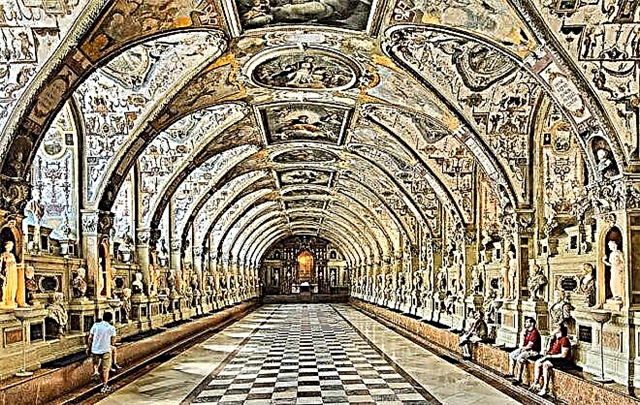If you have to choose where to go - to the residence of the Austrian Habsburgs in the Hofburg, Versailles or the Munich residence of the Bavarian rulers, definitely give preference to the latter. After all, the Munich residence has collected all the best that palaces and castles of past centuries could demonstrate. It is often compared with other royal residences and is always specified - in Bavaria you will find one of the largest palace complexes in Europe in terms of area. The Munich Residence is a real magnet for tourists. Now the premises have been turned into a museum, there are as many as 130 halls in it.

History of the Munich Residence
For the first time, the building, which later became a Bavarian residence, is mentioned in sources from 1385.
It was about Neuvest Castle, which at that time was used as a refuge for the ruling dukes who feared civil riots. Neuveste received the status of an official residence under Wilhelm IV. The building was expanded and rebuilt, turning from a fortification castle into a luxurious palace.
The building is unique, since almost all Bavarian kings contributed to its arrangement:
- Under Albrecht V, many halls were erected, including the Kunstkamera and the Antiquarium. In fact, the king set up a museum in the palace, which became the first European museum on the northern side of the Alps.
- Maximilian I continued to enlarge the residence: during the reign of the duke, the western part of the palace was erected, which now bears his name.
- The idea of building the Green Gallery and the Mirror Cabinet belongs to Charles VII Albrecht.
- And the residence received its final appearance under Louis I.
The residence was built in several stages starting in 1385. It finally turned into a museum in 1920, when Emperor Louis III abdicated his throne, and Germany was recognized as a free state.
However, before that, the king carried out a technical modernization at the residence: he equipped the castle with electric lighting, central heating, modern water supply and elevators.
The first stage of construction
From the time of the construction of the castle-fortress of Neuvesta until 1579, the original building was significantly expanded. The foundations of the premises of the Neuvest castle still exist under the Pharmacy Courtyard and the eastern wing of the Banquet Hall.
The first active arrangement of the residence was undertaken by Albrecht V. Between 1550 and 1579, he built the Antiquarium, which became a storage place for a collection of paintings, coins, Greek and Roman antiques. Unfortunately, the ballroom has not survived.
Second stage of construction
The second stage is devoted to the activities of Wilhelm V. Already in 1581, he started work on the modernization of the Antiquarium. A more luxurious decoration and furnishing of the Antiquarium was conceived. In 1581, next to the residence, the Heir's Chambers and the Widow's Apartments appeared, which have not survived to this day. By 1586, by order of the king, the Courtyard with a grotto was erected.
Third stage of construction
Having taken the throne, Duke Maximilian significantly expanded the courtyard complex. During his reign, the Palace Chapel, the Chapel, the Emperor's Staircase, the Stone Rooms, and the Charlotte Corridor were built. The apartments of the elector's wife appeared no later than 1679, later receiving the name of the Papal Rooms.
Fourth stage of construction
Karl Albrecht considered the residence as a factor allowing him to claim the crown of the Emperor of the Holy Roman Empire, so he put a lot of effort into its arrangement. Under Charles, the interior of all the internal halls was improved, in addition, the king ordered the restoration of part of the palace after the fire. He built the Ancestral Gallery, Luxurious Rooms, Green Gallery and Cabinet of Miniatures.

Fifth stage of construction
The final stage includes the contribution of several rulers of Bavaria at once. In the period from 1811 to 1920, the Palace Riding School, the Royal Chambers, the Hall of the Nibelungen, the Royal Palace Theater, the Church of All Saints, and the Ballroom appeared in the Residence.
What to see for tourists
Even in the days of Louis, the residence was open to curious citizens, however, only by prior agreement and on days when the royal couple were absent. Since 1897, tourists have the opportunity to get on an excursion to the palace, and since 1920, as mentioned above, the building acquires the official status of a historical museum.
Even the most sophisticated tourist is delighted with the number of rooms available for inspection - about 130.
Some rooms have remained in their original form and give an idea of how the emperors lived in the past. Others are given over to huge expositions of rare things, works of art, coins and other collectible objects.
Halls and rooms
The residence, built over several centuries, combines a variety of architectural styles: Renaissance, Baroque, Rococo and Classicism.
A walk through the palace is also a great opportunity to see how the Wittelsbachs lived and how they used architecture and art to prove their power. The halls of the palace contain huge collections of sculptures, paintings, porcelain, silverware and jewelry.
Treasury
The dynasty jewels are located in a separate room - the Treasury. Church relics, works of jewelry art are kept here. The most famous exhibits include the crowns of the Bavarian king and queen, the Statue of St. George, the exquisite Bavarian princess dressing set, consisting of 380 pieces.

The foundation of the treasury was laid by Duke Albrecht V in 1565, his successors significantly increased the collections. The treasury grew even more after the confiscation of the property of many monasteries on the territory of the annexed entity of Kurpfalz.
Antiquarium
One of the oldest, most luxurious and popular halls of the residence is the Antiquarium. The largest Renaissance hall north of the Alps is 66 meters long. It was built by Albrecht to house a collection of antique sculptures.
In the 16th century, Wilhelm, together with his son Maximilian, equipped the Banquet Hall here. For this purpose, the floor was lowered, a balustrade was erected and a fireplace was installed.
Historians believe that the murals on the walls and ceiling of the Antiquarium were created during the perestroika period.
There are sixteen murals on the ceiling dedicated to the figures of Glory and Virtue. The vaults under the windows are decorated with images of cities, palaces and squares. Around them are bizarre ornaments referring to the era of ancient culture. By the way, some sculptures and busts in the Antiquarium are genuine works of the period of classical antiquity, others are Renaissance copies.

The main part of the collection was collected by Albrecht V; the authorship of many of the exhibits has not been established.
Emperor's hall
The room was used for ceremonies, and Maximilian was the first to build it. The ceiling of the hall is traditionally decorated with murals; in this hall, drawings are dedicated to female figures acting in the role of Reason and Virtue. The three main murals symbolize Monarchy, Glory and Wisdom. The same theme continues on tapestries created by the Dutch master Hans van der Bist.

Previously, the main decoration of the hall was the red statue of Virtue; unfortunately, it has not survived to this day; sculpture adorned the mantelpiece.
Ancestor gallery
Ahnengalerie - art gallery with 121 portraits of representatives of the Wittelsbach dynasty and Charlemagne. All paintings are inserted into gilded carved panels, the walls of the room are additionally decorated with artistic plaster.
Karl Albert at one time wanted to extract practical benefits for himself with the help of the Ancestor Gallery. The king wanted to demonstrate to the whole world the breadth of dynastic ties and its importance. He fought for the throne of the Holy Roman Emperor and managed to win a political battle. Under the name of Charles, he was crowned in Frankfurt am Main.
Porcelain room
Inside there is an exposition of porcelain from such places as Meissen, Sevres, Nymphenburg. The same Karl Albrecht decided to create a room, wishing to keep the ancestral treasure in it.
The collection, which was previously located in the Treasury, was moved to the Porcelain Hall, since the room could no longer contain all the relics and values.
The special perception of the room - visual distortion and visual enlargement - is due to the fact that the room is decorated with mirrors. They whimsically reflect both the room and the products.
Royal chambers
The Königsbau or Royal Chambers is a room that some of the kings of Bavaria lived in.
It all started from the moment when Elector Maximilian Joseph IV became the first king of the historical region in 1806. It turned out that the residence has no chambers that correspond to the new high status. Maximilian began construction, but it was the king's son, Ludwig I, who was destined to finish it. From the design of the room, it is noticeable how much the new ruler was fond of Italy and the Renaissance in general. The facade of the building was designed by the architect Leo von Klenze after the model of the Palazzo Pitti.
Hall of Hercules
The Hall of Hercules was the name given to the room that in the past served as the Throne Room. The room got its unusual name because of the huge tapestries dedicated to the twelve exploits of the hero of antiquity Hercules. The tapestries were custom-made by Albrecht V and created in 1565 for his residence in Dachau. Later they were transported here.
The hall is distinguished by excellent acoustics, it is not surprising that now the room is used as a concert hall. The Bavarian Radio Orchestra, Munich Symphony Orchestra, some popular performers and representatives of jazz music perform here.
Halls of the Nibelungen

The Wittelsbach residence is famous for a whole complex of halls named after the Nibelungen. The fact is that the murals in these rooms depict the scenes described in the "Song of the Nibelungs". In the first hall, the main characters of the epic are drawn, in all subsequent ones - plot scenes, for example, Siegfried's marriage to Kriemhild.
Black hall
Schwarzer Saal appeared in the Munich residence during the reign of William V, and received its name later - in 1623. The room was originally called the Hall of Perspective because of the ceiling painting by Hans Werl. Later, portals imitating black marble were installed in the room.
However, ceiling paintings are still considered the most captivating element of this room, and are the first attempt at creating an architectural illusion in Germany. The technique was borrowed from Italian masters. The artist used oil paints, the drawings created on canvas were attached to the ceiling with frames.
Rooms of the Palace Garden
The palace garden in the Residence of Maximilian I in 1613 in connection with the next expansion of the territory. The king planned to build a garden behind the moat, with many circular paths, fountains, hedges and alleys planted with mulberries.

By 1616, the project acquired the Pavilion of the Goddess Diana, since then it has been repeatedly redeveloped in accordance with popular architectural trends. The idea of the rooms in the palace garden also belongs to Maximilian, however, the original chambers overlooking the Palace garden were destroyed during the Second World War.
What tourists can see today is the second part of the rooms built by Maximilian on the site of more ancient buildings. They contain interior items that were previously located in the Chambers of the palace garden, including the personal belongings of the first king of Bavaria. By visiting the Palace Rooms, tourists will have the opportunity to learn how the kings lived.
Exposure
The residence of the Bavarian kings is a real treasure, and we are talking not only about the room where the relics are kept, but also about the numerous exhibitions inside.
Porcelain collection
The most expensive exhibit of the entire collection is the unique Onyx service, which includes 717 items. The Nymphenburg manufactory was engaged in its manufacture for thirteen years. The service was named so because of its color - all items were made with a purple background imitating the color of the semi-precious onyx stone.
In addition, the exhibition contains works of porcelain art from other factories in Sèvres in France and Royal in Berlin. It is also worth paying attention to the plates: many of them are decorated with drawings telling about the heroes of the German medieval epic.
Miniature collection
Before the spread of photography, miniatures were in their prime. It fell on the XVI-XIX centuries.
This art form captivated Klaus and Helga Nottbom so much that they put together a whole collection. The exposition is striking in the number of portraits, still lifes and landscapes in a variety of techniques - from watercolor to enamel over silver and copper.
Collection of silver items
The exposition is collected from items that the guests of the Munich residence used in everyday life.
The following story is connected with the silver from this collection: during the Thirteen Years War, the Swedes tried to withdraw some of the items on a ship, but their ship was wrecked and sank in the Inn River in 1648. Almost all of the cargo was later lifted from the bottom.

The most famous exhibit is the silver service by Maximilian Josef. Real royal luxury is noticeable in it: the famous jewelers from Paris Guillaume Bienne, Claude Odio were engaged in the manufacture of 502 items. They spent two years of work on one set.
Church robes collection
Such a collection became possible thanks to Maximilian, who bought many valuable fabrics in Italy at the beginning of the 17th century. Of these, church robes were sewn in the royal workshops. They are the ones that guests of the Munich Palace can see today.
Coin Museum
It is in the Munich residence that one of the world's largest coin collections is kept. Albrecht V began collecting them in 1570. Later, Charles II Theodor combined the collections of Bavaria and the Palatinate as part of the unification of these two regions.
Today the Hall of Coins contains more than three hundred thousand coins, banknotes and medallions.
The museum allows you to see how the coin business has changed and developed from antiquity to the present day.
The most valuable exhibits are considered: coins of the Greeks, Celts, Romans, medieval coins, carved stone products - gems and cameos.
The hall continues to be replenished with exhibits such as credit cards.
Opening hours
The residence is located at Residenzstraße 1, 80333 München, Germany.
An entrance ticket can be purchased for each museum separately, or you can buy a combined one. Approximate prices are as follows: Residence Museum - 7 euros, Treasury - 7 euros, Theater - 3 euros. You can save money by purchasing a general pass to all three museums for 13 euros.
If the visitor does not know in which of the three museum complexes the room or hall of interest is located, you need to check this with the ticket seller.

From April 1 to October 15, the palace is open for visits from 9.00 to 18.00 hours.
During the cold season, the opening hours change, and you can only get inside from 10.00 to 17.00. The residence is closed for visits only a few times a year: on Catholic Christmas, New Year's, Thursday at Shrove Tuesday.
How to get there
The easiest way to get to the residence is by metro:
- S-Bahn: S1, S2, S4-8, stop Marienplatz;
- by U-Bahn: U3, U6 stop Marienplatz, U3-U6 Odeonsplatz.
You can find out the latest information on the appointment or cancellation of special routes, as well as other useful information, on the official website.
Conclusion
The Munich residence has functioned for several centuries.All this time, the rulers of Bavaria were completing the building, improving and decorating it with the most expensive and beautiful interior elements.
Many rulers were avid collectors, so nowadays guests of the residence can admire not only the decoration of luxurious halls, but also large-scale exhibitions of jewelry, porcelain, and silver.
The residence invites guests on excursions, it is allowed to take photos.











